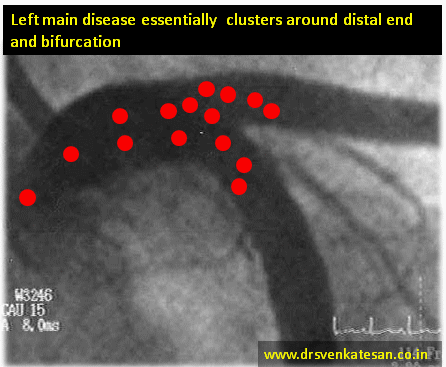Distribution of Left main disease.
- Ostial
- Ostio-proximal (Within 1 cm of origin )
- Shaft -Discrete mid left main
- Shaft -Diffuse
- Isolated distal shaft( 1.0.0)
- Bifurcation ( Medina 1.1.0 -LAD)*
- Bifurcation (Median 1.1.0-LCX)
- Bifurcation ( Median 1.1.1)*
- Trifurcation ( With ramus )
* These three locations account for nearly 75% of all left main lesions.
We know atherosclerosis is a branch point disease .Normal left main measures 1 mm to 20mm.The shorter the left main lesser is the the incidence of LMD. Short left main can not engage the atherosclerosis much (No left main = No left main disease ) However ,very short left mains may increase ostial lesions .
- The commonest left main lesion is distal left main with one of the branch involvement (1.1.0.LAD is more common )
- Least common entity is discrete mid shaft lesion.
Simple strategy.
First dictum : All complex looking LMDs should be referred to a good surgeon.
Final dictum : Remember medical management for left main disease is still an accepted strategy in stable , non flow limiting situations .
Interventional Cardiologists feel they have the exclusive rights to indulge between these two spectrum of LMD .May be true! But extreme caution is required as we are playing our game in the most critical coronary high way .
Some suggestions and thoughts.
- 50 % diameter stenosis is significant. But significance does not mean we should tackle the lesion by aggression.
- Symptomatic flow limiting lesion only to be intervened . (Flow limiting means both angiographic and a stress test .FFR <.8 is also an index for flow limiting .Symptom means Angina on exertion )
- IVUS, OCT, FFR,NIR ,SYNTAX are not path breaking tools .They essentially add more glamor to left main disease than anything .
- Most bifurcation LMDs are managed by single stent with stent jailing the major side branch (Yes side branch can be LCX !)
- However ,two stent strategies is not banished .It can be vastly superior in some selected cases .(Especially with huge plaque load at carina )But needs expertise .
- In very small vessels two stent strategies are risky .
Reference (2012 update)






